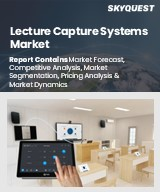
|
시장보고서
상품코드
1822528
세계의 유아 교육(ECE) 시장 : 예측 - 유형별, 연령층별, 프로그램 형태별, 서비스 유형별, 최종 사용자별, 지역별 분석(-2032년)Early Childhood Education Market Forecasts to 2032 - Global Analysis By Type, Age Group (Infants, Toddlers, Preschool, and Kindergarten ), Program Mode, Service Type, End User and By Geography |
||||||
Stratistics MRC에 따르면 세계의 유아 교육(ECE) 시장은 2025년에 117억 달러로 추정되고, 예측 기간 동안 CAGR 12.9%로 성장할 전망이며, 2032년에는 274억 달러에 이를 전망입니다.
유아 교육(ECE) 시장에는 0-8세 어린이를 대상으로 인지적, 정서적, 사회적 발달을 중시한 교육 프로그램, 커리큘럼, 서비스가 포함됩니다. 여기에는 프리스쿨, 데이케어 센터, 디지털 학습 플랫폼, 교사 훈련 솔루션 등이 포함됩니다. 부모의 의식이 높아지고 정부의 이니셔티브, 디지털 도입에 힘입어 시장은 세계적으로 확대되고 있습니다. 양질의 조기 학습, 혁신적인 교육법, 브렌디드 러닝 솔루션에 대한 수요 증가가 성장을 추진하고 있으며, ECE는 평생 학습과 발달 성과를 얻기 위한 중요한 기반으로 자리매김하고 있습니다.
유니세프에 따르면, 5세 미만의 2억 5,000만 명 이상의 어린이들이 양질의 조기 교육을 받지 못하기 때문에 잠재적인 발달 능력을 충분히 발휘할 수 없는 위험에 노출되어 있습니다.
인식 증가
유아 교육의 중요성에 대한 인식 증가는 시장 확대에 큰 영향을 미칩니다. 보호자와 정책 입안자는 현재 조기 학습이 인지적 및 사회적 발달의 기초를 구축한다는 것을 이해하고 있습니다. 이러한 인식은 양질의 교육 프로그램에 대한 수요가 증가하고 정부와 민간 부문이 조기 교육 이니셔티브에 투자하도록 촉구하고 있습니다. 그 결과 교육기관은 이 수요에 부응하기 위해 제공하는 서비스를 확대하여 시장 성장을 가속하고 있습니다.
제한된 액세스
유아 교육에 대한 접근은 특히 시골 지역이나 충분한 서비스를 받지 못한 도시 지역에서는 여전히 큰 과제가 되고 있습니다. 불충분한 인프라, 교육받은 교육자의 제한된 가용성, 재정적 제약 등의 요인은 고품질 교육 센터의 설립을 방해하고 있습니다. 이러한 접근 제한으로 인해 많은 어린이들이 조기 학습의 혜택을 누릴 수 없으므로 시장 성장이 막히고 교육 불평등이 지속됩니다.
프랜차이즈로 확대
프랜차이즈는 유아 교육 제공업체에게 사업 확장을 목표로 하는 효과적인 성장 전략입니다. 입증된 커리큘럼과 운영 모델을 갖춘 확립된 브랜드는 프랜차이즈를 통해 새로운 장소에서도 성공을 재현할 수 있습니다. 이 접근법을 통해 신속한 확장, 브랜드 인지도 향상, 다양한 지역에서 높은 품질의 유아 교육 서비스에 대한 수요에 부응할 수 있습니다.
사립 및 공립 교육기관 증가
사립 및 공립 유아 교육기관의 급증으로 시장 경쟁이 치열해지고 있습니다. 선택 증가는 소비자들에게 이익을 가져올 수 있지만, 기존 교육 제공업체들에게는 질, 저렴한 가격, 독특한 서비스 제공을 통해 차별화를 도모할 필요가 있습니다. 이러한 경쟁 구도는 경영자원을 핍박하게 하고 수요가 높아짐에 따라 교육기관이 높은 수준을 유지하는 것을 어렵게 합니다.
COVID-19의 영향 :
COVID-19의 대유행은 유아 교육을 세계적으로 혼란시켜 교육기관의 일시적인 폐쇄나 원격 학습으로의 이행을 초래했습니다. 이 전환은 디지털 디바이드를 부각시키고 많은 가정이 필요한 기술을 이용할 수 없는 상황에 빠졌습니다. 게다가 팬데믹에 의해 재원이 핍박했기 때문에, 유아 교육 분야에서는 고용이 상실되어 취학자수의 유지가 과제가 되었습니다. 부흥에 대한 노력은 진행되고 있지만, 장기적인 영향은 업계의 정세에 영향을 계속 주고 있습니다.
예측 기간 동안 전일제 프로그램 부문이 최대가 될 전망
전일제 프로그램은 일하는 보호자의 스케줄에 합치하고 있기 때문에 예측 기간 중, 최대 시장 점유율을 차지할 것으로 예측됩니다. 이 프로그램은 종합적인 관리와 학습 경험을 제공하며 공동 작업 가구의 요구를 충족시킵니다. 전일제 프로그램이 제공하는 편의성과 종합적인 발달은 선호하는 선택이기 때문에 성장을 가속하고 시장 최대의 부문으로서의 지위를 굳힙니다.
예측 기간 동안 유아(0-2세) 분야의 CAGR이 가장 높아질 것으로 예측됩니다.
예측 기간 동안 영유아(0-2세) 부문은 조기 개입과 발달 지원으로의 전환을 반영하여 가장 높은 성장률을 나타낼 것으로 예측됩니다. 이 시기의 중요한 발달의 고비를 인식해, 부모 및 돌봄인은 유아 특유의 요구에 대응하는 전문 프로그램을 요구하게 되어 있습니다. 이 추세는 삶의 초기 단계에서 기초 학습과 관리를 중시하는 경향이 강해지고 있음을 뒷받침합니다.
최대 점유율을 차지하는 지역 :
북미는 견고한 인프라, 높은 학부모 의식, 정부의 많은 투자를 배경으로 유아 교육 분야에서 가장 큰 시장 점유율을 유지할 것으로 예측됩니다. 미국과 캐나다와 같은 국가들은 접근성과 질을 증진시키는 정책에 힘입어 종합적인 조기 교육 시스템을 수립하고 있습니다. 이 탄탄한 토대를 통해 이 지역은 입학자 수 및 시장 규모에 이르고 있습니다.
CAGR이 가장 높은 지역 :
아시아태평양은 급속한 도시화, 가처분 소득 증가, 교육 중시 증가에 힘입어 유아 교육의 연평균 성장률이 가장 높을 것으로 예측됩니다. 중국과 인도와 같은 국가들은 성장하는 인구 수요에 대응하기 위해 조기 교육 인프라에 많은 투자를 하고 있습니다. 이러한 조기 교육에 대한 관심은 이 지역 시장 성장을 가속화하고 있습니다.
무료 사용자 정의 서비스 :
이 보고서를 구독하는 고객은 다음 무료 맞춤설정 옵션 중 하나를 사용할 수 있습니다.
- 기업 프로파일
- 추가 시장 기업의 종합적 프로파일링(3개사까지)
- 주요 기업의 SWOT 분석(3개사까지)
- 지역 세분화
- 고객의 관심에 응한 주요국 시장 추계, 예측 및 CAGR(주 : 타당성 확인에 따름)
- 경쟁 벤치마킹
- 제품 포트폴리오, 지리적 존재, 전략적 제휴에 기반한 주요 기업 벤치마킹
목차
제1장 주요 요약
제2장 서문
- 개요
- 이해관계자
- 조사 범위
- 조사 방법
- 데이터 마이닝
- 데이터 분석
- 데이터 검증
- 조사 접근
- 조사 자료
- 1차 조사 자료
- 2차 조사 정보원
- 전제조건
제3장 시장 동향 분석
- 성장 촉진요인
- 성장 억제요인
- 기회
- 위협
- 최종 사용자 분석
- 신흥 시장
- COVID-19의 영향
제4장 Porter's Five Forces 분석
- 공급기업의 협상력
- 구매자의 협상력
- 대체품의 위협
- 신규 참가업체의 위협
- 경쟁 기업간 경쟁 관계
제5장 세계의 유아 교육 시장 : 유형별
- 종일 프로그램
- 반나절 프로그램
- 몬테소리 프로그램
- 플레이그룹 및 취학전 프로그램
- 기타 유형
제6장 세계의 유아 교육 시장 : 연령층별
- 유아(0-2세)
- 유아(2-3세)
- 유치원(3-5세)
- 유치원(5-6세)
제7장 세계의 유아 교육 시장 : 프로그램 형태별
- 전통적인 교실 베이스
- 온라인 학습 및 블렌드 학습
- 재택 교육 프로그램
제8장 세계의 유아 교육 시장 : 서비스 유형별
- 커리큘럼 및 수업 계획
- 교사의 연수 및 개발
- 학습 평가 및 평가
- 지육 완구 및 학습 교재
- 과외 활동
제9장 세계의 유아 교육 시장 : 최종 사용자별
- 공립학교
- 사립학교 및 유치원
- 데이 케어 센터
- 재택 학습자
- NGO 및 비영리 단체
제10장 세계의 유아 교육 시장 : 지역별
- 북미
- 미국
- 캐나다
- 멕시코
- 유럽
- 독일
- 영국
- 이탈리아
- 프랑스
- 스페인
- 기타 유럽
- 아시아태평양
- 일본
- 중국
- 인도
- 호주
- 뉴질랜드
- 한국
- 기타 아시아태평양
- 남미
- 아르헨티나
- 브라질
- 칠레
- 기타 남미
- 중동 및 아프리카
- 사우디아라비아
- 아랍에미리트(UAE)
- 카타르
- 남아프리카
- 기타 중동 및 아프리카
제11장 주요 발전
- 계약, 파트너십, 협업 및 합작투자
- 인수 및 합병
- 신제품 발매
- 사업 확대
- 기타 주요 전략
제12장 기업 프로파일링
- Bright Horizons Family Solutions
- KinderCare Learning Companies
- Learning Care Group
- G8 Education
- Goodstart Early Learning
- Busy Bees Learning Centers
- The Learning Experience
- Primrose Schools
- Benesse Holdings
- Noah Education Holdings
- Etonkids Educational Group
- Spring Education Group
- Cadence Education
- Kids'R'Kids International
- Pearson Education
- Scholastic Corporation
- Houghton Mifflin Harcourt
According to Stratistics MRC, the Global Early Childhood Education (ECE) Market is accounted for $11.7 billion in 2025 and is expected to reach $27.4 billion by 2032 growing at a CAGR of 12.9% during the forecast period. The Early Childhood Education (ECE) market encompasses educational programs, curricula, and services designed for children aged 0-8 years, emphasizing cognitive, emotional, and social development. It includes preschools, daycare centers, digital learning platforms, and teacher training solutions. Driven by increasing parental awareness, government initiatives, and digital adoption, the market is expanding globally. Rising demand for quality early learning, innovative pedagogies, and blended learning solutions is propelling growth, positioning ECE as a critical foundation for lifelong learning and developmental outcomes.
According to UNICEF, over 250 million children under age 5 are at risk of not reaching their full developmental potential due to lack of access to quality early education.
Market Dynamics:
Driver:
Increasing Awareness
The growing recognition of early childhood education's importance has significantly influenced market expansion. Parents and policymakers now understand that early learning lays the foundation for cognitive and social development. This awareness has led to increased demand for quality educational programs, prompting governments and private sectors to invest in early education initiatives. Consequently, educational institutions are expanding their offerings to meet this demand, thereby driving market growth.
Restraint:
Limited Access
Access to early childhood education remains a significant challenge, particularly in rural and underserved urban areas. Factors such as inadequate infrastructure, limited availability of trained educators, and financial constraints hinder the establishment of quality educational centers. This limited access prevents many children from benefiting from early learning experiences, thereby restricting market growth and perpetuating educational inequalities.
Opportunity:
Expansion through Franchising
Franchising presents a viable growth strategy for early childhood education providers aiming to expand their reach. Established brands with proven curricula and operational models can replicate their success in new locations through franchising. This approach allows for rapid scaling, increased brand recognition, and the ability to meet the rising demand for quality early education services across diverse regions.
Threat:
Rising Number of Private and Public Institutions
The proliferation of both private and public early childhood education institutions has intensified competition within the market. While increased options benefit consumers, they also pressure existing providers to differentiate themselves through quality, affordability, and unique offerings. This competitive landscape can strain resources and challenge institutions to maintain high standards amidst growing demand.
Covid-19 Impact:
The COVID-19 pandemic disrupted early childhood education globally, leading to temporary closures of institutions and a shift to remote learning. This transition highlighted the digital divide, with many families lacking access to necessary technology. Additionally, the pandemic strained financial resources, leading to job losses within the sector and challenges in maintaining enrollment numbers. While recovery efforts are underway, the long-term effects continue to influence the industry's landscape.
The full-day programs segment is expected to be the largest during the forecast period
The full-day programs segment is expected to account for the largest market share during the forecast period due to their alignment with working parents' schedules. These programs provide comprehensive care and learning experiences, accommodating the needs of dual-income households. The convenience and holistic development offered by full-day programs make them a preferred choice, thereby driving their growth and solidifying their position as the largest segment in the market.
The infants (0-2 Years) segment is expected to have the highest CAGR during the forecast period
Over the forecast period, the infants (0-2 Years) segment is predicted to witness the highest growth rate, reflecting a shift towards early intervention and developmental support. Recognizing the critical developmental milestones during this age, parents and caregivers are increasingly seeking specialized programs that cater to infants' unique needs. This trend underscores the growing emphasis on foundational learning and care during the earliest stages of life.
Region with largest share:
North America is projected to maintain the largest market share in early childhood education, driven by robust infrastructure, high parental awareness, and significant government investment. Countries like the United States and Canada have established comprehensive early education systems, supported by policies that promote accessibility and quality. This strong foundation enables the region to lead in both enrollment numbers and market value.
Region with highest CAGR:
The Asia Pacific region is expected to witness the highest compound annual growth rate in early childhood education, fueled by rapid urbanization, increasing disposable incomes, and a growing emphasis on education. Countries like China and India are investing heavily in early education infrastructure to meet the demands of their expanding populations. This focus on early learning is propelling the region's market growth at an accelerated pace.
Key players in the market
Some of the key players in Early Childhood Education (ECE) Market include Bright Horizons Family Solutions, KinderCare Learning Companies, Learning Care Group, G8 Education, Goodstart Early Learning, Busy Bees Learning Centers, The Learning Experience, Primrose Schools, Benesse Holdings, Noah Education Holdings, Etonkids Educational Group, Spring Education Group, Cadence Education, Kids 'R' Kids International, Pearson Education, Scholastic Corporation, and Houghton Mifflin Harcourt.
Key Developments:
In August 2025, G8 Education welcomed the introduction of the Early Childhood Education and Care Bill, aiming to strengthen child safety regulations in the sector.
In June 2025, Busy Bees announced the upcoming 3-Day Subsidised Childcare Guarantee, set to begin in January 2026, offering families three days of subsidized early learning per week.
Types Covered:
- Full-Day Programs
- Part-Day Programs
- Montessori Programs
- Playgroup & Pre-K Programs
- Other Types
Age Groups Covered:
- Infants (0-2 Years)
- Toddlers (2-3 Years)
- Preschool (3-5 Years)
- Kindergarten (5-6 Years)
Program Modes Covered:
- Traditional Classroom-Based
- Online & Blended Learning
- Home-Based Education Programs
Service Types Covered:
- Curriculum & Lesson Planning
- Teacher Training & Development
- Learning Assessment & Evaluation
- Educational Toys & Learning Materials
- Extracurricular Activities
End Users Covered:
- Public Schools
- Private Schools & Preschools
- Daycare Centers
- Home-Based Learners
- NGOs & Non-Profit Organizations
Regions Covered:
- North America
- US
- Canada
- Mexico
- Europe
- Germany
- UK
- Italy
- France
- Spain
- Rest of Europe
- Asia Pacific
- Japan
- China
- India
- Australia
- New Zealand
- South Korea
- Rest of Asia Pacific
- South America
- Argentina
- Brazil
- Chile
- Rest of South America
- Middle East & Africa
- Saudi Arabia
- UAE
- Qatar
- South Africa
- Rest of Middle East & Africa
What our report offers:
- Market share assessments for the regional and country-level segments
- Strategic recommendations for the new entrants
- Covers Market data for the years 2024, 2025, 2026, 2028, and 2032
- Market Trends (Drivers, Constraints, Opportunities, Threats, Challenges, Investment Opportunities, and recommendations)
- Strategic recommendations in key business segments based on the market estimations
- Competitive landscaping mapping the key common trends
- Company profiling with detailed strategies, financials, and recent developments
- Supply chain trends mapping the latest technological advancements
Free Customization Offerings:
All the customers of this report will be entitled to receive one of the following free customization options:
- Company Profiling
- Comprehensive profiling of additional market players (up to 3)
- SWOT Analysis of key players (up to 3)
- Regional Segmentation
- Market estimations, Forecasts and CAGR of any prominent country as per the client's interest (Note: Depends on feasibility check)
- Competitive Benchmarking
- Benchmarking of key players based on product portfolio, geographical presence, and strategic alliances
Table of Contents
1 Executive Summary
2 Preface
- 2.1 Abstract
- 2.2 Stake Holders
- 2.3 Research Scope
- 2.4 Research Methodology
- 2.4.1 Data Mining
- 2.4.2 Data Analysis
- 2.4.3 Data Validation
- 2.4.4 Research Approach
- 2.5 Research Sources
- 2.5.1 Primary Research Sources
- 2.5.2 Secondary Research Sources
- 2.5.3 Assumptions
3 Market Trend Analysis
- 3.1 Introduction
- 3.2 Drivers
- 3.3 Restraints
- 3.4 Opportunities
- 3.5 Threats
- 3.6 End User Analysis
- 3.7 Emerging Markets
- 3.8 Impact of Covid-19
4 Porters Five Force Analysis
- 4.1 Bargaining power of suppliers
- 4.2 Bargaining power of buyers
- 4.3 Threat of substitutes
- 4.4 Threat of new entrants
- 4.5 Competitive rivalry
5 Global Early Childhood Education Market, By Type
- 5.1 Introduction
- 5.2 Full-Day Programs
- 5.3 Part-Day Programs
- 5.4 Montessori Programs
- 5.5 Playgroup & Pre-K Programs
- 5.6 Other Types
6 Global Early Childhood Education Market, By Age Group
- 6.1 Introduction
- 6.2 Infants (0-2 Years)
- 6.3 Toddlers (2-3 Years)
- 6.4 Preschool (3-5 Years)
- 6.5 Kindergarten (5-6 Years)
7 Global Early Childhood Education Market, By Program Mode
- 7.1 Introduction
- 7.2 Traditional Classroom-Based
- 7.3 Online & Blended Learning
- 7.4 Home-Based Education Programs
8 Global Early Childhood Education Market, By Service Type
- 8.1 Introduction
- 8.2 Curriculum & Lesson Planning
- 8.3 Teacher Training & Development
- 8.4 Learning Assessment & Evaluation
- 8.5 Educational Toys & Learning Materials
- 8.6 Extracurricular Activities
9 Global Early Childhood Education Market, By End User
- 9.1 Introduction
- 9.2 Public Schools
- 9.3 Private Schools & Preschools
- 9.4 Daycare Centers
- 9.5 Home-Based Learners
- 9.6 NGOs & Non-Profit Organizations
10 Global Early Childhood Education Market, By Geography
- 10.1 Introduction
- 10.2 North America
- 10.2.1 US
- 10.2.2 Canada
- 10.2.3 Mexico
- 10.3 Europe
- 10.3.1 Germany
- 10.3.2 UK
- 10.3.3 Italy
- 10.3.4 France
- 10.3.5 Spain
- 10.3.6 Rest of Europe
- 10.4 Asia Pacific
- 10.4.1 Japan
- 10.4.2 China
- 10.4.3 India
- 10.4.4 Australia
- 10.4.5 New Zealand
- 10.4.6 South Korea
- 10.4.7 Rest of Asia Pacific
- 10.5 South America
- 10.5.1 Argentina
- 10.5.2 Brazil
- 10.5.3 Chile
- 10.5.4 Rest of South America
- 10.6 Middle East & Africa
- 10.6.1 Saudi Arabia
- 10.6.2 UAE
- 10.6.3 Qatar
- 10.6.4 South Africa
- 10.6.5 Rest of Middle East & Africa
11 Key Developments
- 11.1 Agreements, Partnerships, Collaborations and Joint Ventures
- 11.2 Acquisitions & Mergers
- 11.3 New Product Launch
- 11.4 Expansions
- 11.5 Other Key Strategies
12 Company Profiling
- 12.1 Bright Horizons Family Solutions
- 12.2 KinderCare Learning Companies
- 12.3 Learning Care Group
- 12.4 G8 Education
- 12.5 Goodstart Early Learning
- 12.6 Busy Bees Learning Centers
- 12.7 The Learning Experience
- 12.8 Primrose Schools
- 12.9 Benesse Holdings
- 12.10 Noah Education Holdings
- 12.11 Etonkids Educational Group
- 12.12 Spring Education Group
- 12.13 Cadence Education
- 12.14 Kids 'R' Kids International
- 12.15 Pearson Education
- 12.16 Scholastic Corporation
- 12.17 Houghton Mifflin Harcourt



















